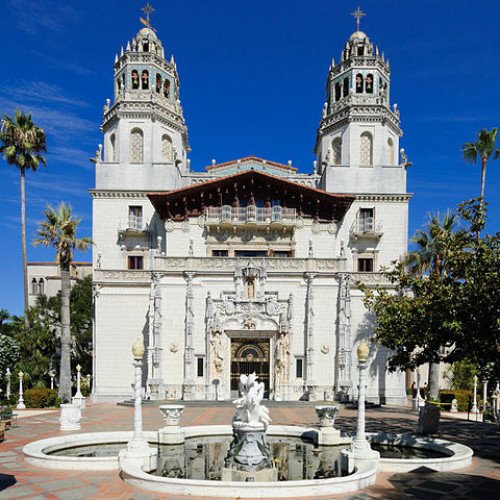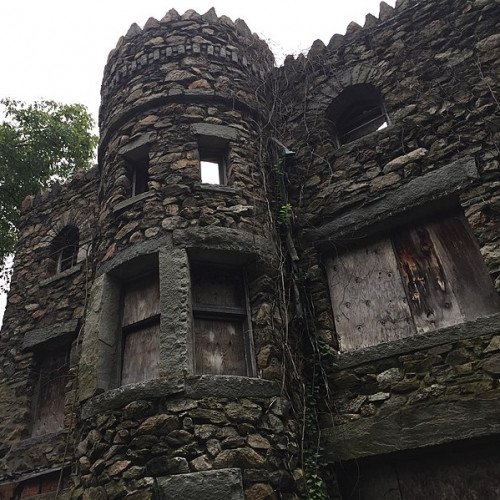Castles of "United States" HEARST CASTLE vs HEARTHSTONE CASTLE

HEARST CASTLE
Hearst Castle, San Simeon, is a National Historic Landmark and California Historical Landmark located on the Central Coast of California in the United States. Conceived by William Randolph Hearst, the publishing tycoon, and his architect Julia Morgan, it was built between 1919 and 1947. Known formally as "La Cuesta Encantada" (The Enchanted Hill), and often referred to simply as San Simeon, Hearst called his castle “the ranch". His father George Hearst had purchased the original 40,000 acres (162 km2) estate in 1865 and Camp Hill, the site for the future Hearst Castle, was used for family camping vacations during Hearst's youth. In 1919 Hearst inherited some $11 million (equivalent to $164,197,697 in 2020) and estates including the land at San Simeon. He used his fortune to further develop his media empire of newspapers, magazines and radio stations, the profits from which supported a lifetime of building and collecting. Within a few months of Phoebe Hearst's death, he had commissioned Morgan to build "something a little more comfortable up on the hill", the genesis of the present castle. Morgan was an architectural pioneer; "America's first truly independent female architect", she was the first woman to study architecture at the School of Beaux-Arts in Paris, the first to have her own architectural practice in California and the first female winner of the American Institute of Architects Gold Medal. Working in close collaboration with Hearst for over twenty years, the castle at San Simeon is her best-known creation. In the Roaring Twenties and into the 1930s, Hearst Castle reached its social peak. Originally intended as a family home for Hearst, his wife Millicent and their five sons, by 1925 he and Millicent had effectively separated and he held court at San Simeon with his mistress, the actress Marion Davies. Their guest list comprised most of the Hollywood stars of the period; Charlie Chaplin, Cary Grant, the Marx Brothers, Greta Garbo, Buster Keaton, Mary Pickford, Jean Harlow and Clark Gable all visited, some on multiple occasions. Political luminaries encompassed Calvin Coolidge and Winston Churchill while other notables included Charles Lindbergh, P. G. Wodehouse and Bernard Shaw. Visitors gathered each evening at Casa Grande for drinks in the Assembly Room, dined in the Refectory and watched the latest movie in the theater before retiring to the luxurious accommodation provided by the guest houses of Casa del Mar, Casa del Monte and Casa del Sol. During the days, they admired the views, rode, played tennis, bowls or golf and swam in the "most sumptuous swimming pool on earth". While Hearst entertained, Morgan built; the castle was under almost continual construction from 1920 until 1939, with work resuming after the end of World War II until Hearst's final departure in 1947.
Statistics for this Xoptio

HEARTHSTONE CASTLE
Hearthstone Castle in Danbury, Connecticut, was built between 1895 and 1899. It was listed on the National Register of Historic Places in 1987. It has also been known as Parks' Castle and as The Castle. The property includes four contributing buildings and three other contributing structures. Today, the castle is owned by the City of Danbury and is located in Tarrywile Park. Hearthstone Castle is slated to be renovated into an observation deck. First known as "Sanford Castle", Hearthstone was designed by architect Ernest G. W. Dietrich for its first owner, E. Starr Sanford, a noted portrait photographer. The castle was intended to be a honeymoon "cottage" for Sanford's wife. Sanford and his family owned the castle for only five years before selling it in 1902 to Victor Buck, a retired New York industrialist. When the Buck family moved in, they renamed the castle "Buck's Castle." In 1910, Charles Darling Parks bought the neighboring Tarrywile Mansion from Dr. William C. Wiles. Later, in 1918, C. D. Parks then bought "Buck's Castle" for his oldest daughter, Irene Parks, as a wedding gift. During this time the castle was renamed "Hearthstone Castle." The name was possibly changed to this due to the eight fireplaces, which were all made out of stone, as was the rest of the castle. All the rock that was used to build the castle was quarried on site, and transported the short distance across the property on a small railroad, which was built solely for this purpose. All the woodwork throughout the building of the castle was brought in from Italy. All the wrought iron chandeliers, lamps, and wall sconces were made in Danbury by Cephas B. Rogers Co.